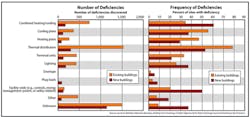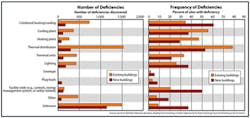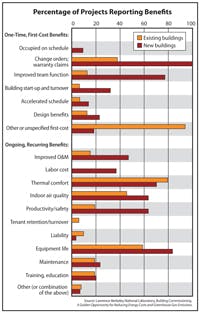5 Steps to Commissioning Success
Commissioning isn’t just a buzzword, it’s a value-added service that improves project outcomes and is something owners are willing to pay for when they see the value of it. Sometimes a poor previous experience with commissioning turns owners off, but these five commissioning-process success tactics can help ensure a positive and productive commissioning
program on your jobs.
1. Start Early
The commissioning authority’s (CxA’s) job is to find and resolve issues. The sooner that process begins the better for everyone, as it will save time and effort to identify issues early (i.e., before they’re sealed above walls or ceilings, before the same issue has occurred 100 similar times, and before the building is turned-over and occupied).
A schedule that shows commissioning occurring during a two-week period in a placeholder at the end of the schedule doesn’t cut it. Request commissioning activity sequence and duration information from the CxA at the start of construction. The sequence and duration information may reveal hidden scheduling favorabilities or requirements that help or hinder the commissioning effort without having a significant impact on overall construction.
Since commissioning is focused on systems as opposed to individual components, having a functional system as early as possible can allow the CxA to begin that work while construction is ongoing. For example, if a building has four wings, and the central plant is in the fourth wing to be completed, then all commissioning is on hold contingent to getting the central plant online.
onversely, if the central plant wing were constructed first, the commissioning of the associated air systems could proceed as the other three wings were constructed, thereby allowing commissioning to move in step with construction, rather than waiting to the end.
2. Meet Often
Commissioning should not occur in a vacuum. The CxA owns neither the design nor the equipment being tested, so any issues identified — whether design- or construction-related — need to be brought to the project team for resolution.
The CxA can’t issue design direction to the contractor. If issues arise that appear to require design-team input, they need to be communicated to the design team either by a request for information or through the commissioning issue reporting process. The easiest way to explain the finding and explore its resolution is during face-to-face meetings between the design team, the contractor, and the CxA.
The CxA writes test plans for equipment functionality testing, but the responsibility for demonstrating successful operation should rest on the contractor. You don’t want a commissioning authority to cause damage to equipment or systems, either by accident or ignorance, so contractor representation should be on-hand to operate the equipment for the CxA. Coordinating this test participation and scheduling is best accomplished during face-to-face meetings with all stakeholders so that all restrictions and requirements can be identified and evaluated.
3. Maximize Training
If often seems as though operator training is an afterthought both in the design and at project completion. The project specifications call for seemingly arbitrary blocks of time to train on certain systems with no indication of a syllabus or curriculum. Some systems seem to have too much time devoted to them, while others fall short. What’s the right amount of time to train the operators? How should the instruction be given? What should the course content be? These questions are often left to the contractor to resolve at the end of the project. The CxA should be evaluating the training agenda and facilitating owner/operator participation in the training.
What makes effective training? Knowing your audience. For example, the maintenance department at your school district project doesn’t need four hours of training for the domestic water heaters, they just need to know a few key elements:
• where are the isolation valves located?
• what do I do when the unit fails?
• where do I get spare parts?
• is it supposed to do that?
That final question covers anything “special” about a particular installation that should be addressed in training. For example, if the water heaters can be scheduled on and off via the building automation system, then the operators should know that the heaters will shut off at night and on weekends. That will save confusion when the kitchen water heaters don’t start up at 5:30 a.m., if they’re scheduled on with the rest of the campus at 7:30 a.m.
The commissioning authority should be working with the owner to guide the contractor’s development of the training curriculum. Develop a training matrix that shows the systems on which training will occur, who the required attendees are, and the learning objectives of the session. The CxA should review this matrix and provide feedback regarding session length, attendees, and learning objectives/content.
Having trained operators helps with the project’s persistent performance. Operators who understand the system are better equipped to run the system. This will reduce warranty calls and improve client satisfaction. Use your training time to make operators out of your client’s maintenance group.
4. Trending
Building codes and rating systems such as Leadership in Energy and Environmental Design (LEED) have helped standardize the building commissioning service offering, but one thing that is not part of these minimum requirements is a post-occupancy analysis of the systems’ automatic operation over time.
Thanks to the march of technology, most projects have a computerized building automation system capable of storing sensor and command data in a database that can be retrieved in a raw data format for further analysis. This data may be zone temperature data, air handler commands, exhaust fan on/off scheduling, etc., and can be analyzed by the CxA to document the automatic operation of the system at the time of turnover. Not only does this provide a baseline for the system and extra assurance that the project meets the contract requirements and design intent, it can also identify further issues that don’t manifest during the functional testing phase.
Unlike functional testing, which is a snapshot of the equipment operation to verify the sequence of operation is implemented correctly for a particular system, trend logging over time shows the building’s ability to operate as intended and will illustrate inter-system interactions over entire 24-hour periods. This may reveal that certain zones are driving entire systems that impact comfort and energy performance. For example, a room may struggle to reach set point, causing the air handler to have higher than normal discharge temperatures; addressing this one zone could allow the air handler to back off and improve the rest of the building. Holistic evaluations of performance are accomplished most easily utilizing digital tools that are probably already built into the project.
5. Keep Commissioning Involved
The commissioning authority can provide value to the project by identifying potential issues and by facilitating solutions, but only if they are in the communication loop. Often, the CxA is not aware of change orders, RFIs, or submittals. The CxA drafts functional test scripts based on the latest information he or she has available, usually the contract documents. Field conditions that differ from that information automatically qualify as commissioning issues. These spurious issues can be avoided if the CxA’s reference documentation is kept up to date. Is it the contractor’s responsibility to ensure the CxA gets all the required documentation? Maybe, maybe not, but this line of communication should be discussed at the commissioning kick-off meeting to help facilitate keeping all parties on the same page (literally).
A Word About Communication
The commissioning process is seen to have the most validity and integrity when commissioning findings and reports are provided directly to the owner. Whether contracted directly in a third-party scenario, as part of a design/build team, or as a service provided by the contractor, unfiltered communication to the owner ensures the independent judgment and objectivity of the commissioning authority. The five commissioning-process success tactics outlined here apply to whatever contracting methodology is used on your next (or current) job.
Jeff L. Yirak, P.E. LEED AP BD+C, O+M, is associate, commissioning, at Wood Harbinger, Bellevue, WA, and treasurer for the Northwest Chapter of the Building Commissioning Association. He is an independent commissioning service provider who contracts both directly through to the owner and to the contractor. He can be reached at 425/628-6041, or by email at [email protected].


